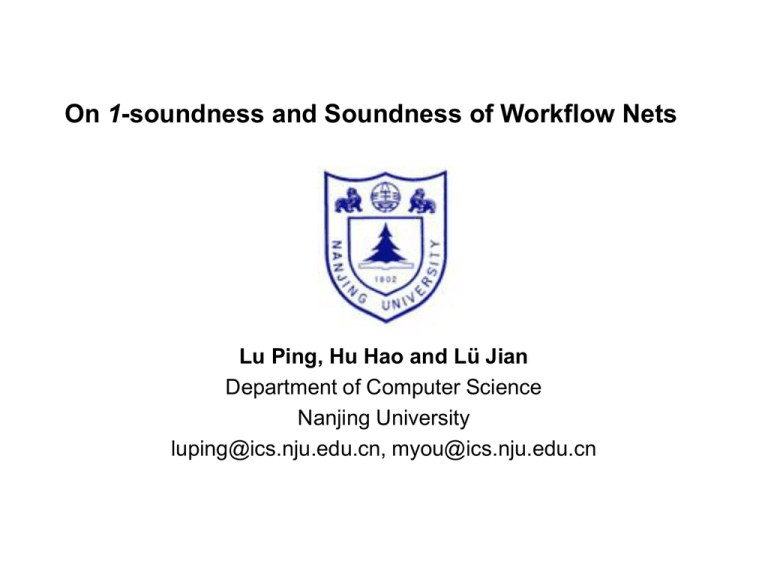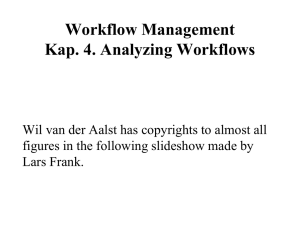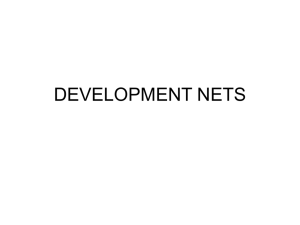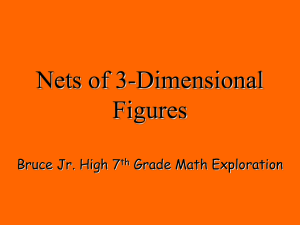Document
advertisement

On 1-soundness and Soundness of Workflow Nets
Lu Ping, Hu Hao and Lü Jian
Department of Computer Science
Nanjing University
luping@ics.nju.edu.cn, myou@ics.nju.edu.cn
Contents
Introduction to Workflow Nets
Basic Properties of Workflow Nets
Establishing Relationship Between 1-soundness and
Soundness
WRI Workflow Nets
Conclusion
Introduction to Workflow Nets
Workflow Nets
Workflow Nets is a special kind of Petri Nets (proposed by Prof. Aalst) for
workflow modeling (control-flow dimension). It specifies the partial ordering
of tasks. Tasks are represented by transitions in Petri nets, the ordering
between tasks are represented by arcs and places. Workflow nets give a
solid theoretical foundation for workflow modeling.
Definition (WF-net, by Aalst)
A Petri net PN = (P, T, F) is a WF-net iff:
(1) PN has two special places: i and o. Place i is a source place: i = ø.
Place o is a sink place: o = ø.
(2) If we add a transition t* to PN so that t* = {o} and t* = {i}, then the
resulting Petri net is strongly connected. (PN*, the extended net of PN)
Introduction to Workflow Nets
Correctness Issues on Workflows
No deadlocks
No dangling tasks
Termination guaranteed
…
Definition (1-soundness, by Aalst).
A WF-net PN = (P, T, F) is 1-sound if and only if:
*
*
(1) M ([i]
M) (M
[o])
*
(2) M ([i]
M M [o]) (M = [o])
*
t
(3) t T M, M’ [i]
M
M’
Introduction to Workflow Nets
Composition of Workflow Nets
PN3 = PN1 t PN2
ta
i2
t
PN2
PN1
o2
tb
Introduction to Workflow Nets
1-soundness is not compositional
If we use a 1-sound WF-net to replace a transition of another 1-sound one,
the result may not be 1-sound.
Definition (K-soundness, by Kees van Hee et al.)
A WF-net PN = (P, T, F) is k-sound for a natural number k if and only if:
*
*
(1) M ([ik]
M) (M
[ok])
t
*
(2) t T M, M’ [ik]
M
M’
Introduction to Workflow Nets
Definition (Soundness, by Kees van Hee et al.)
A WF-net PN is sound if for all natural number k, PN is k-sound.
Soundness is compositional and decidable
Kees van Hee et al. proved that soundness is compositional, that is, if we
replace a transition in a sound WF-net by another sound one, the result WFnet is also sound. They also proved that soundness is decidable. A decision
procedure is proposed. However, it is still to be investigated how to solved
the problem of soundness effectively and what complexity the algorithm
would have.
We find that for some kinds of WF-nets, soundness
can be decided effectively
Basic Properties of Workflow Nets
Property (by Aalst).
For a WF-nets PN, PN is 1-sound iff (PN*, [i]) is live and bounded.
Property.
If a 1-sound WF-net PN is k-sound, then for all natural numbers p < k, PN is
p-sound.
Property.
If a 1-sound WF-net PN is not k-sound, then for all natural numbers p > k,
PN is not p-sound.
Property.
For an arbitrary 1-sound WF-net PN, either it is sound or there exists a
natural number k so that p < k, PN is p-sound and q k, PN is not qsound.
Basic Properties of Workflow Nets
Property.
Let PN1 be k-sound WF-net, PN2 be sound WF-net and t be a transition of
PN1, PN3 = PN1 t PN2 is also k-sound.
This property is useful during workflow nets composition when we only want
to ensue the 1-soundness of the resulting WF-net.
Establishing Relationship Between
1-soundness and Soundness
Several specific kinds of WF-nets are examined by
Aalst and efficient algorithms are found to decide
their 1-soundness
Prof. Aalst examined three kinds of WF-nets – free-choice WF-nets, wellhandled WF-nets and s-coverable WF-nets. For the former two kinds of WFnets, the well-formedness of their extended net (1-soundness) can be
decided in polynomial time. The s-coverable WF-nets is the generalization
of the former ones.
For the above kinds of WF-nets, can soundness be
implied by 1-soundness?
Establishing Relationship Between
1-soundness and Soundness
Definition (ST-AC WF-net).
A WF-net PN is a ST-AC WF-net if PN* is an asymmetric choice Petri net
and every siphon of it contains at least a trap.
Properties on ST-AC WF-net
For a well-formed ST-AC Petri net, it is live and bounded if and only if every
siphon of it is marked (by L. Jiao). Also every minimal siphon of a live and
bounded ST-AC net is an S-component of the net (by L. Jiao). For a 1sound ST-AC WF-net PN, the net system (PN*, [i]) is live and bounded. So
the marking [i] marks every siphon in the net PN*. Therefore the marking [ik]
also marks every siphon in PN* and the net system (PN*, [ik]) is live and
bounded for any natural number k.
Establishing Relationship Between
1-soundness and Soundness
Theorem
For ST-AC WF-nets, 1-soundness implies soundness.
(Proof.) Suppose for a 1-sound ST-AC WF-net PN, PN is not k-sound. The
requirement (1) of the k-soundness must not hold. So for (PN, [ik]), there
exists a marking M reachable from [ik] so that [ok] can not be reached from
x
M. In PN, let M
M’ so that from M’, no tokens can be put into place o.
At M’ the number of tokens in place o must less than k. In the system (PN*,
[ik]), the marking M’ can also be reached from [ik]. Let M’’ = M’ – M’|o, then
(PN*, M”) is bounded but not live. But since every minimal siphon in PN* is
an S-component and each contains k tokens at [ik], then at M’’, each
minimal siphon in PN* must be marked and (PN*, M”) is live. So we get a
contradiction.
Establishing Relationship Between
1-soundness and Soundness
Corollary
For free-choice and extended free-choice WF-nets, 1-soundness implies
soundness.
( An extended free-choice net is also an asymmetric choice net. For a 1sound extended free-choice net PN, (PN*, [i]) is live and bounded, so every
siphon of PN* must contain a trap (Commoner’s Theorem). So a 1-sound
extended free-choice WF-net is also a 1-sound ST-AC WF-net)
Corollary
For free-choice and extended free-choice WF-nets, their soundness can be
decided in polynomial time.
Establishing Relationship Between
1-soundness and Soundness
Definition (Well-handledness, WH WF-nets, by Aalst)
A Petri net PN is well-handled if for any pair of nodes x and y such that one
of the nodes is a place and the other a transition and for any pair of
elementary paths Ca and Cb leading from x to y, if Ca and Cb have only
nodes x and y in common, Ca and Cb must be identical. A WF-net PN is a
well-handled WF-net if PN* is well-handled.
x
y
x
y
Establishing Relationship Between
1-soundness and Soundness
Definition (Conflict free, ENSeC net, ENSeC WF-net)
Let PN be a Petri net and C = <n1, …, nk> be a path in PN, C is conflict-free
iff for any transition ni of the path, j i -1 nj ni. Let PN be a Petri net,
PN is an Extended Non-Self Controlling (ENSeC) net iff for every pair of
transition t1 and t2 such that t1 t2 ø , there does not exist a conflictfree path leading from t1 to t2. A WF-net PN is an ENSeC WF-net if PN* is
an ENSeC net.
Properties on ENSeC WF-net
For ENSeC Petri net system (PN, M), if it is live and bounded then PN is Scoverable. If (PN, M) is bounded, it is live if and only if every minimal siphon
is a marked state-machine at M. For a 1-sound ENSeC WF-net PN, (PN*, [i])
is live and bounded, so (PN*, [ik]) is live and bounded for any natural
number k.
Establishing Relationship Between
1-soundness and Soundness
Theorem
For ENSeC WF-nets, 1-soundness implies Soundness
(Proof.) Let PN be a 1-sound ENSeC WF-net, suppose PN is not k-sound.
For PN, we can find a marking M’ reachable from [ik] so that from M’, no
more tokens can be put into place o. In the system (PN*, [ik]), let M’’ = M’M’|o, then (PN*, M’’) is not live. But since every minimal siphon is an statemachine at [ik], at M’’ they must also be marked, so (PN*, M’’) is also live.
Corollary
For well-handled WF-nets, 1-soundness implies soundness.
( A well-handled WF-net is also an ENSeC WF-net, by Prof. Aalst)
Corollary
For well-handled WF-nets, their soundness can be decided in polynomial
time.
Establishing Relationship Between
1-soundness and Soundness
The s-coverable WF-nets are the generalization of
the free-choice and well-handled WF-nets, does their
1-soundness implies soundness?
We only have the partial results on the SMA (state-machine-allocatable)
WF-nets, a subset of s-coverable WF-nets
For SMA WF-nets, their 1-soundness implies
Soundness
For SMA WF-nets, their soundness can be decided in
polynomial time
Establishing Relationship Between
1-soundness and Soundness
Does 1-soundness imply soundness for s-coverable
WF-nets?
Does 1-soundness imply soundness for asymmetricchoice WF-nets?
Liveness monotonicity does not hold for asymmetric-choice net since there
may be siphons that do not contain any trap in a live asymmetric-choice net.
However, we believe that restricted liveness monotonicity (Let PN be an ACnet, (PN, [ik]) is live if (PN, [i]) is live) does hold for asymmetric-choice net.
Such a property may be necessary in the prove if 1-soundness does imply
soundness for AC WF-nets.
Well-handled with Regular Iteration Nets
Definition (Well-handled and Acyclic Workflow Nets)
A WF-net PN is WA WF-net if PN is well-handled and acyclic
Property
For a WA WF-net PN, PN is a free-choice WF-net and also a well-handled
WF-net
t*
t1
p
p1
t
t
p2
t2
i
p
o
Well-handled with Regular Iteration Nets
Theorem
For a WA WF-net PN, PN is sound
(Proof.) Since PN* is well-handled, no circuit of PN* has PT- or TP-handle.
So (PN*, [i]) is bounded and covered by s-component (by J. Esparza). PN*
is free-choice, we proved that every minimal siphon of PN* must be a trap.
Thus, (PN*, [i]) is live.
PN* = (P*, T*, F*)
A siphon PH that is not a
trap. PH = (H, H, F*) in
which F* = F* ((H H)
( H H))
i
t’ o
p
V
t
Structure that is not well-handled
Well-handled with Regular Iteration Nets
Definition (Well-handled with Regular Iteration Nets)
(1) A WA WF-net is a WRI WF-net
(2) Let PN1 and PN2 be two WRI WF-nets, PN3 = PN1 t PN2 is a WRI
WF-net.
(3) Let PN1 and PN2 be two WRI WF-nets, PN3 = PN1 t PN2* is a WRI
WF-net
(4) WRI WF-nets could only be obtained by (1), (2) and (3)
Theorem
WRI WF-nets are sound workflow nets.
(Proof. Let PN1 and PN2 to two 1-sound and safe WF-nets, PN3 = PN1 t
PN2 or PN3 = PN1 t PN2*, it’s easy to see that PN3 is also 1-sound and
safe. Moreover, WRI WF-nets are free-choice WF-nets, so their 1soundness implies soundness)
Well-handled with Regular Iteration Nets
WRI WF-nets support hierarchical modeling of
workflows naturally
(1) First, the sketch of a workflow process is modeled by a WA WF-net,
those iterations and subnets to be refined are represented by special
transitions.
(2) Those special transitions are replaced by WA WF-nets or by WA WFnets’ extended nets in which special transitions may also exist to represent
the subnets or iterations to be modeled next.
(3) We continue the above modeling process until there is no more
iterations and subnets to be refined in our workflow model.
(4) By the definition of WRI WF-net, the workflow model we get is a WRI
WF-net and its soundness is ensured. At each step, the verification task is
rather simple.
Well-handled with Regular Iteration Nets
An example using WRI WF-nets modeling workflows
dummy_task
register
dummy_task
dummy_task
send_questionnaire
process_required
process_NOK
process_complaint
evaluate
handle_questionnaire
time_out process_questionnaire
process_until_OK
check_processing
processing no_processing
p
dummy_task
dummy_task
archive
dummy_task
PN3
PN4
PN1
PN2
Well-handled with Regular Iteration Nets
WRI WF-nets do not fit for modeling all workflow
models.
When complex synchronizations exist in workflow models, it may be hard to
use WRI WF-nets to model them.
time_out
send_questionnaire
process_questionnaire
archive
register
evaluate
no_processing
processing_OK
process_required
process_complaint check_processing
processing_NOK
Conclusion
In this paper we
(1) Examined the relationship between 1-soundness, k-soundness and
soundness of workflow nets
(2) Proved that for several kinds of WF-nets, their soundness can be
decided effectively
(3) Proposed a specific workflow model – WRI WF-nets which are inherently
sound. Gave a way to use WRI WF-nets modeling workflows hierarchically.
References
[1] W. van der Aalst. Workflow Verification: Finding Control-Flow Errors Using Petri-NetBased Techniques. Business Process Managements: Models, Techniques, and
Empirical Studies 2000.
[2] K. van Hee, N. Sidorova, and M. Voorhoeve. Soundness and Separability of Workflow
Nets in the Stepwise Refinement Approach. In W. van der Aalst, Application and
Theory of Petri Nets 2003.
[3] K. van Hee, N. Sidorova, and M. Voorhoeve. Generalised Soundness of Workflow
Nets is Decidable. Application and Theory of Petri Nets 2004.
[4] J. Desel, J. Esparza. Free choice Petri nets.
[5] L. Jiao, T. Cheung, and W. Lu. On Liveness and Boundedness of Asymmetric Choice
Nets. In Theoretical Computer Science, 2004.
[6] K.Barkaoui, J.M.Couvreur, and C.Dutheillet. On Liveness in Extended non SelfControlling Nets. Application and Theory of Petri Nets 1995.
[7] J. Esparza, M. Silva. Circuits, Handles, Bridges and Nets. Advances in Petri Nets
1990.
Thank you !









